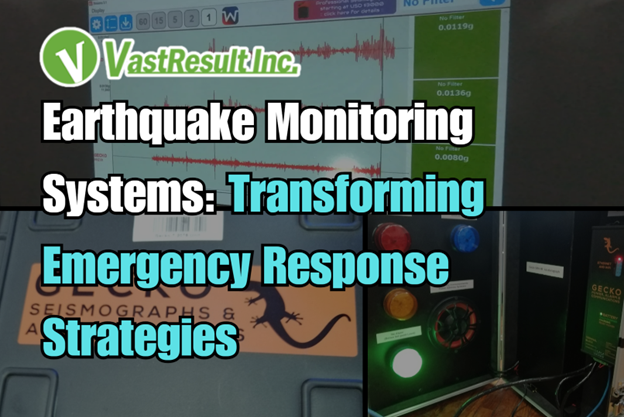
In earthquake-prone regions, the speed and accuracy of response efforts can mean the difference between widespread destruction and saved lives. Earthquake monitoring systems have become indispensable in modern disaster management, offering real-time data that can initiate emergency protocols, guide rescue operations, and help protect infrastructure. These systems don’t just detect earthquakes—they transform how communities prepare, respond, and recover. And that’s exactly why they matter: they provide critical seconds and insights when they’re needed most.
How Earthquake Monitoring Systems Work
Earthquake monitoring relies on an integrated network of tools that detect, measure, and communicate seismic activity. Seismometers record ground motion and pinpoint the origin and strength of an earthquake. Accelerographs capture intense shaking at specific locations, which is vital for assessing structural stress in real-time. GPS monitoring helps track gradual tectonic movements over time, offering insights into long-term fault behavior. Early warning systems detect the first seismic waves and trigger alerts before the stronger shaking begins, while communication systems ensure information reaches responders immediately.
By working together, these instruments create a full picture of seismic events, enabling faster and more informed decisions during emergencies.
Faster Alerts, Faster Action
One of the greatest advantages of monitoring systems is their ability to provide alerts within seconds of a quake starting. This early notification can initiate safety protocols—such as pausing trains, stopping elevators, or sending mass alerts—before the strongest waves arrive. In settings like hospitals, schools, or industrial sites, even a few seconds of preparation can significantly reduce injuries and equipment damage, offering a critical window to act before impact.
Targeted and Smarter Emergency Response
Real-time data allows emergency responders to assess which locations were hit hardest and how severely they were affected. Instead of spreading resources evenly, authorities can concentrate efforts in the most affected zones. This focused strategy prevents delays, supports faster rescues, and ensures that those in immediate danger receive help first.
Infrastructure Protection and Damage Control
When violent shaking occurs, utility systems such as gas, electricity, and water are vulnerable to secondary disasters. Earthquake monitoring systems can trigger automatic shutdowns of these utilities to reduce the risk of fires, leaks, or electrical accidents. This not only protects people and property during the event but also speeds up recovery efforts by limiting additional damage.
Data-Driven Insights for Safer Future Planning
After an earthquake, recorded data is essential for analyzing how buildings and infrastructure responded. Engineers and planners can use this information to improve construction standards, strengthen vulnerable structures, and refine emergency strategies. Over time, this data contributes to smarter urban development and more resilient communities.
Boosting Public Awareness and Trust
Reliable and visible earthquake monitoring encourages people to take safety protocols seriously. When alerts are consistent and timely, individuals are more likely to follow emergency instructions, reducing panic and confusion during critical moments. This trust supports smoother evacuations and more coordinated responses.
Why Earthquake Monitoring Systems Are Important
1. They Save Lives
Earthquake monitoring systems can detect seismic waves within seconds of an event occurring. These systems are capable of triggering early warning alerts before the most damaging shaking reaches populated areas. Even a 5 to 30-second head start can allow individuals to evacuate hazardous areas, take cover under sturdy furniture, or pause high-risk operations like surgeries, industrial processes, or public transportation systems. In schools, hospitals, and public transport systems, this brief warning can prevent injuries and fatalities—especially in high-density urban areas where chaos can escalate quickly without warning.
2. They Reduce Damage
Real-time earthquake monitoring can automatically activate fail-safe systems. For example, gas valves can shut off to prevent explosions, elevators can be brought to the nearest floor and opened, power grids can isolate unstable regions, and chemical plants can halt operations. These automated responses limit secondary disasters such as fires, chemical spills, and electrocution hazards. In earthquake-prone areas, this feature saves millions in infrastructure repairs and ensures that damage is contained, not compounded.
3. They Guide Emergency Response
Seismic sensors collect and transmit live data on the location, depth, and intensity of an earthquake. This data is used to generate shake maps that identify which zones experienced the most intense ground motion. Emergency responders use this information to prioritize deployment—sending search and rescue teams to the hardest-hit areas first, ensuring medical aid goes where it’s needed most, and speeding up overall response time. Without this precision, emergency efforts may be misdirected or delayed, costing precious lives and resources.
4. They Strengthen Future Planning
The data collected from each earthquake event doesn’t just disappear—it becomes part of a larger archive used by urban planners, engineers, and geologists. Analyzing this information helps identify patterns in fault behavior, informs the development of earthquake-resistant building codes, and guides the retrofitting of older, vulnerable infrastructure. Over time, this continuous feedback loop leads to smarter city planning, stronger buildings, and long-term risk reduction, especially in regions with aging infrastructure or rapid development.
5. They Build Public Confidence
Knowing that earthquake monitoring systems are in place and functioning properly helps reduce fear and panic among the public. People are more likely to follow safety instructions and emergency protocols when they trust the system that is guiding them. Public education campaigns paired with reliable alerts also increase awareness and community preparedness, turning panic into purposeful action. This widespread trust helps emergency efforts proceed more smoothly and ensures greater participation in drills and safety measures.
Turning Technology Into Protection
Earthquake monitoring systems are powerful tools that elevate how communities prepare for and respond to seismic events. They reduce harm by enabling faster responses, protecting infrastructure, guiding rescue efforts, and informing long-term safety improvements. As technology continues to advance, these systems will remain a cornerstone of disaster resilience strategies—empowering people to act quickly, recover faster, and build safer environments for the future.
At VastResult, we design and install advanced earthquake monitoring solutions tailored to your facility’s needs. Our team helps integrate monitoring systems with emergency plans, supports data interpretation, and ensures compliance with industry standards.
Whether you manage a commercial facility, public institution, or high-risk infrastructure, we help you stay ready with technology that protects lives and property. Contact us at (02) 0804 0740 or email us at sales@vastresult.com to inquire.
